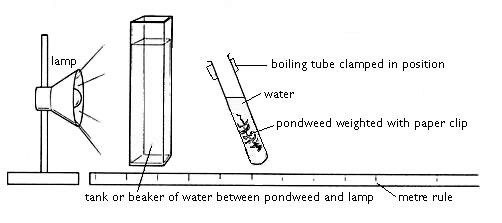Investigating factors affecting the rate of photosynthesis
Class practical
In this experiment the rate of photosynthesis is measured by counting the number of bubbles rising from the cut end of a piece of Elodea or Cabomba.
Lesson organisation
The work could be carried out individually or in groups of up to 3 students (counter, timekeeper and scribe).
Apparatus and Chemicals
Students may choose to use:
Hot water
Ice
Thermometer, –10 °C –110°C
Balance
Coloured filters or light bulbs
Stopclock
Push-button counter
Potassium hydrogencarbonate powder or solution (Hazcard 95C describes this as low hazard)
For each group of students:
Student sheets, 1 per student
Beaker, 600 cm3, 1
Metre ruler, 1
Elodea (Note 1) or other oxygenating pond plant (Note 2)
Scissors
Forceps
Electric lamp
Clamp stand with boss and clamp
Health & Safety and Technical notes
Normal laboratory safety procedures should be followed.
There is a slight risk of infection from pond water, so take sensible hygiene precautions, cover cuts and wash hands thoroughly after the work is complete.
1 Elodea can be stored in a fish tank on a windowsill, in the laboratory or prep room. However it is probably a good idea to replace it every so often with a fresh supply from an aquarist centre or a pond. (It’s worth finding out if any colleague has a pond.) On the day of the experiment, cut 10 cm lengths of Elodea, put a paper-clip on one end to weigh them down and place in a boiling tube of water in a boiling tube rack, near a high intensity lamp, such as a halogen lamp or a fluorescent striplight. Check the Elodea to see if it is bubbling. Sometimes cutting 2–3 mm off the end of the Elodea will induce bubbling from the cut end or change the size of the bubbles being produced.
2 Cabomba (available from pet shops or suppliers of aquaria – used as an oxygenator in tropical fish tanks) can be used as an alternative to Elodea, and some people find it produces more bubbles. It does, though tend to break apart very easily, and fish may eat it very quickly.
3 If possible, provide cardboard to allow students to shield their experiment from other lights in the room.
Ethical issues
Look out for small aquatic invertebrates attached to the pond weed used, and remove them to a pond or aquarium.
Procedure

a Set up the apparatus as shown in a darkened room.
b Look for a stream of bubbles coming from the cut end of the pondweed.
c Count the number of bubbles produced in 1 minute. Repeat twice and calculate a mean bubble count – number of bubbles per minute. This is the mean rate of bubble production.
d Change one factor that may affect the rate of photosynthesis, keeping all other factors the same as far as possible. (Refer to teaching notes.)
e Leave for 2 minutes and then take counts of the number of bubbles produced in one minute. Repeat the count and calculate the mean rate of bubble production as before.
f Change the factor being varied to another value and leave the pond weed for 2 minutes. Take bubble counts and calculate the mean bubbles / minute for the new value.
g Plot data on a line graph. The values for the factor being varied should be on the x-axis, and the mean bubble rate in bubbles / minute should be on the y axis.
Teaching notes
An assumption being made in this experiment is that the gas bubbles being counted are only oxygen, and that production of oxygen is proportional to the rate of photosynthesis. Another assumption is that all the bubbles are the same size. A variable that is hard to control is the effect of temperature as the lights used may heat the water. LED lamps produce less heat.
You can develop more accurate measures by collecting the gas produced and measuring the volume of gas produced each minute (or over longer time periods). One method of doing this is to cut the graduated portion from the tube of a plastic teat pipette, fill the tube with water, plug the smaller hole with plasticine or blu-tack and invert the tube over the bubbling stem.
The students can be allocated to investigate a particular factor that affects the rate of photosynthesis, or they can choose from this list, or they can develop their own ideas.
- Light intensity or distance of the Elodea from the lamp. (Light intensity is proportional to 1/distance2.
- Temperature of the water
- Carbon dioxide concentration. Add 0.05 g of potassium hydrogencarbonate at a time. The available mass of carbon dioxide increases with each addition.
- Acidity: use buffer solutions to maintain different pHs.
- Colour of light. Coloured filters can be used, but these will affect light intensity by different amounts depending on the colour.
Students should collect and set up all the other apparatus before collecting the boiling tube of pond weed. Check the weed to see if it is bubbling. Sometimes cutting 2–3 mm off the end of the weed will induce bubbling from the cut end, or change the size of the bubbles being produced.
The students could develop this practical as an assessed investigation if they develop hypotheses and plan the experimental detail from the core protocol.
Health and safety checked, September 2008
Downloads
Download the student sheet ![]() Investigating factors affecting the rate of photosynthesis (76 KB) with questions and answers
Investigating factors affecting the rate of photosynthesis (76 KB) with questions and answers


